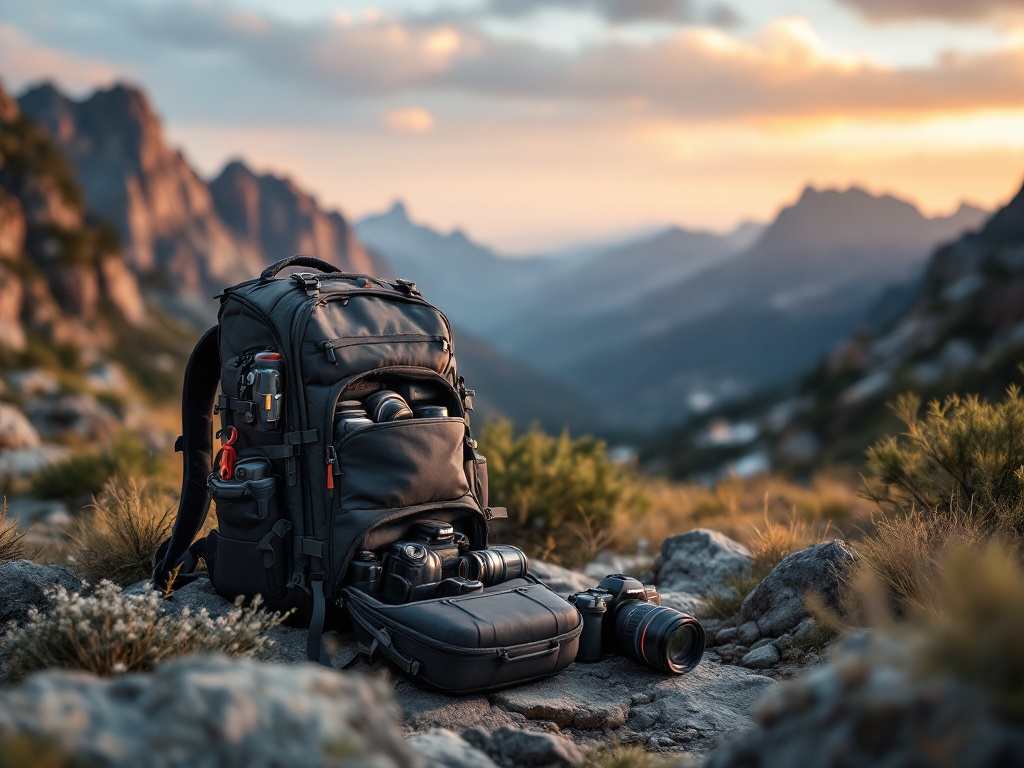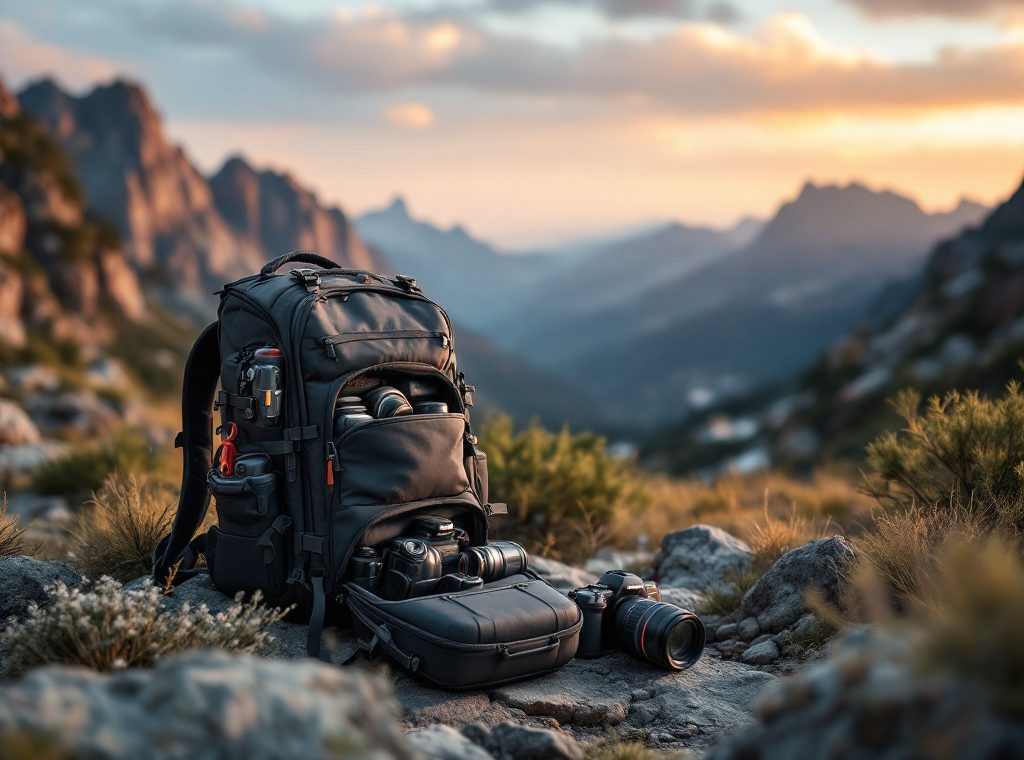Travel Photography Gear: How to Protect Your Equipment While Traveling
Are you ready to capture stunning travel photos but worried about keeping your expensive gear safe? From bumpy flights to crowded markets, travel exposes your equipment to theft, damage, and the elements. This guide reveals essential tips and strategies, from choosing the right protective gear like anti-theft backpacks and hard-shell cases, to packing light and creating a robust backup system. Discover how to safeguard your investment and ensure your precious memories are protected, so you can focus on capturing breathtaking images. Explore expert advice and practical steps to travel with confidence, knowing your photography gear is secure.
Important information

- Use padded cases, hard-shell cases, waterproof and dustproof bags, and anti-theft backpacks for comprehensive gear protection.
- Always keep camera equipment in carry-on luggage, especially batteries, and store it under the seat for security.
- Specialized camera gear insurance is crucial for covering potential loss, theft, or damage.
- Back up photos frequently on multiple memory cards, a portable hard drive, and cloud storage.
- Use accessories like wrist straps, slings, and fireproof battery bags for added security and convenience.
Understanding the Importance of Protecting Travel Photography Gear
Protecting your valuable camera equipment during travels is essential. Journeys can expose your gear to various risks, including accidental damage, theft, moisture, and dust. Protecting your equipment ensures its longevity, maintains functionality, and allows for uninterrupted memory capturing.
Why specialized travel insurance for camera gear is indispensable
Standard travel insurance policies may not adequately cover high-value items or professional equipment. Specialized camera gear insurance protects against loss, theft, and damage, addressing specific risks faced by cameras, lenses, and accessories. It guarantees replacement or repair when necessary, offering invaluable peace of mind, especially for frequent travelers.
Additional protective measures for your equipment
- Keep your camera equipment in your carry-on luggage to prevent potential mishandling during transit.
- Use padded camera bags and cases for essential protection.
- Add extra padding, such as clothing, for an additional layer of security.
- Maintain vigilance, especially in crowded areas and during security checks, to minimize theft or damage risks.
Choosing the Right Bags and Cases for Safety
Protecting your valuable camera equipment during travel requires a multi-layered approach. Anti-theft backpacks are your first line of defense, with concealed zippers and slash-resistant fabrics deterring potential thieves. For superior impact, water, and dust protection, especially for air travel, hard shell cases are essential. To safeguard your gear from rain, snow, or sand, waterproof and dustproof bags are crucial. Padded cases provide additional cushioning for delicate components during transit. Combining these protective measures ensures comprehensive security for your photography equipment, preparing you for any travel scenario.
Using Anti-Theft Backpacks for Security
Protect your valuable camera gear with an anti-theft backpack, especially while traveling. These backpacks offer enhanced security features to deter thieves and safeguard your equipment. Lockable zippers prevent quick access to your gear, while slash-resistant fabric adds another layer of protection against potential theft. Hidden pockets offer secure storage for smaller valuables like memory cards and batteries. Many anti-theft backpacks also include RFID-blocking technology, which protects your credit cards and passport data from electronic theft, a particularly valuable feature in crowded tourist areas. While these features significantly enhance security, remember to remain vigilant by keeping your bag close and choosing an inconspicuous design to avoid attracting unwanted attention to your valuable equipment.
The Advantages of Hard Shell Cases
Hard shell cases offer superior impact protection, essential for air travel, safeguarding your equipment during transit.
- impact protection, essential for air travel.
- safeguarding your equipment during transit.
They are often waterproof and dustproof, protecting gear from the elements.
- waterproof.
- dustproof.
- shielding gear from the elements.
Customizable foam interiors minimize movement, keeping everything secure.
Benefits of Waterproof and Dustproof Bags
Safeguard your gear with waterproof bags, shielding it from rain, splashes, and even humidity. This protection is essential for preserving your valuable camera equipment in challenging conditions.
Dustproof bags are equally important, protecting delicate components like lenses and sensors from dust, sand, and dirt. This preventative measure is crucial for maintaining image quality and preventing equipment malfunctions.
Pack both waterproof and dustproof bags for comprehensive protection.
Why Padded Cases Are Essential
Protecting delicate camera gear requires a good padded case to cushion against impacts and minimize damage from bumps or drops. For even greater security, hard-shell cases offer superior protection from crushing, which is crucial for expensive lenses and cameras.
Beyond protection, padded cases also aid organization. Compartments keep items securely in place, preventing shifting during travel and ensuring your gear stays organized on the go.
Packing Strategies for Travel Photography Gear
Traveling light for photography expeditions minimizes the risk of damage or theft. Efficient packing is essential for these trips. Consider using camera cubes for organizing gear and simplifying security checks. Disassembling your tripod and storing it in a padded case offers added protection. Labeling your equipment and concealing logos can deter potential thieves. Using TSA-approved locks offers another layer of security. These precautions protect your valuable gear and provide peace of mind during your travels.
Pack light to minimize damage and theft risks.
Use camera cubes for organized gear and easier security checks.
Disassemble and store your tripod in a padded case for protection.
Label your equipment and conceal logos to deter thieves.
Use TSA-approved locks for added security.
How to Pack Light and Minimize Risk
Traveling light offers several key advantages. Managing a smaller bag is easier and reduces the risk of mishandling and loss. Packing essential gear minimizes potential damage and encourages spontaneous creativity during your trip. This minimalist approach simplifies travel decisions, streamlining your entire journey.
Using Camera Cubes for Organization
Camera cubes provide a smart solution for organizing and protecting your gear. They create padded compartments within your bag, safeguarding your camera, lenses, and accessories. This modular system makes it easy to find what you need and simplifies airport security checks. Most importantly, camera cubes offer crucial protection against damage during travel, ensuring peace of mind.
Disassembling and Packing Large Items
Disassembling large items like tripods and light stands distributes weight and reduces stress on the individual parts during travel.
Detaching lenses from camera bodies protects both from damage while also creating space for tighter packing, minimizing shifts in transit.
Padding each component individually offers additional protection.
Importance of Labeling and Covering Logos
Labeling your lens caps prevents frustrating mix-ups.
Covering brand logos with black gaffer tape deters theft and makes expensive gear less conspicuous, protecting your investment.
Using TSA-Approved Locks for Security
Secure your checked luggage with a TSA-approved lock. These locks allow security personnel to inspect your bags without causing damage, ensuring your belongings remain safe and compliant with regulations. This added security measure effectively deters theft and prevents unauthorized access. Travel with peace of mind by using a TSA-approved lock.
Ensuring Equipment Safety During Air Travel
Safeguard your camera equipment by keeping it in your carry-on luggage to protect it from potential damage or loss.
This is essential for batteries due to fire hazard regulations.
For convenient access and added security, store your gear under the seat in front of you, but be mindful of legroom.
Always confirm your airline’s specific regulations regarding battery types and quantities.
Packing batteries in a fireproof bag offers further protection.
Carrying Camera Gear Onboard
Keep your camera equipment safe by storing it in your carry-on luggage. Checked baggage is often mishandled, leading to potential damage or loss, particularly for fragile items. Protect your valuable gear by keeping it with you.
Storing Camera Gear Under the Seat
Storing your camera gear under the seat in front of you on a flight offers several advantages: convenience, security, and peace of mind. It’s easier to access than items in the overhead bin, plus it’s better protected from shifting luggage or accidental drops. Having your equipment within reach allows you to monitor it throughout the flight.
Handling Batteries and Other Fire Hazards
For safer air travel, pack your batteries in your carry-on bag. This simple precaution helps prevent potential fire hazards during flights.
Protecting Gear from Environmental Hazards
Use rain covers to shield your gear against rain and snow.
For optimal performance in cold temperatures, keep batteries warm.
Use cases with watertight seals to safeguard against moisture and dust.
Add desiccants inside cases to help control humidity.
Use protective filters and avoid direct sunlight to prevent environmental damage.
Use waterproof bags to protect against water damage.
Regularly clean your equipment to prevent dust buildup.
Using Rain Covers for Weatherproofing
Safeguard your valuable photography equipment with rain covers. These protective shields defend against rain, snow, and even humidity. A backpack rain cover efficiently safeguards multiple items at once. Individual camera rain covers are indispensable for shooting in wet conditions. Lightweight, compact, and easily foldable, these covers prevent moisture damage, ensuring your gear functions flawlessly. Protect your investment with rain covers.
Keeping Batteries Warm in Cold Weather
In cold weather, keep your camera batteries warm by storing them close to your body, such as in an inside pocket. This will help them retain their charge and ensure they’re ready when you need to capture that perfect shot.
Daily Cleaning and Maintenance Tips
Clean your camera lens with a microfiber cloth and lens cleaning solution after each use to remove dust and debris for clear images.
Use a blower brush to clean the camera body itself.
Regularly clean your camera sensor to prevent spots.
Store your camera in a cool, dry environment to protect it from moisture damage.
Fully charge your batteries and pack spares before any photo adventure to avoid power interruptions.
Regularly inspect straps and connections for wear and tear, replacing them as needed for secure and reliable operation.
Insurance and Backup Strategies
Protecting your photography gear and your work requires a multi-layered approach. Insuring your equipment safeguards you financially against theft, loss, or damage. Equally vital is protecting your photos. Implement a robust backup system:
- Frequently back up your memory cards.
- Carry multiple memory cards and portable hard drives for on-the-go security.
- Utilize cloud storage for an additional layer of protection and easy file access.
Regular backups ensure your valuable images are safe.
Photography Insurance for Financial Protection
Protect your valuable photography equipment with specialized insurance. Standard policies often lack the comprehensive coverage needed for expensive cameras and gear. Photography insurance offers robust protection against theft, loss, and damage, covering everything from cameras and lenses to essential accessories. This ensures you can quickly repair or replace your equipment when necessary, acting as a crucial safety net for any photographer. Imagine your gear gets damaged while traveling abroad—specialized policies frequently offer worldwide coverage, handling repairs or replacements wherever you are. This specialized coverage provides invaluable peace of mind and is a smart investment for protecting your valuable electronics and livelihood. Get photography insurance today.
Planning a Backup Routine for Memory Cards
Protecting your travel photos is crucial. Implement a robust backup strategy using multiple memory cards for immediate redundancy. A portable hard drive adds extra security, while cloud storage offers convenient access if internet is available. Back up your photos frequently, preferably daily, or at least every few days, to minimize data loss. A laptop is also useful for both storage and image organization.
Safeguard your Memories
- Multiple Memory Cards: Ensure instant redundancy by using multiple memory cards, safeguarding against single card failure.
- Portable Hard Drive: Add an extra layer of protection with a portable hard drive, keeping a physical copy of your precious photos.
Convenient Backup Options
- Cloud Storage: Conveniently access your photos from anywhere with an internet connection using cloud storage.
- Laptop Storage: Utilize a laptop for both storage and organization of your travel images.
Frequent backups, ideally daily, but at least every few days, minimize potential data loss.
Carrying Multiple Memory Cards and External Hard Drives
Protecting your photos and videos is essential. Using multiple memory cards and an external hard drive provides excellent security. If one card fails, backups on other cards preserve your memories. Regularly transferring files to an external drive frees up card space and adds another security layer. This minimizes data loss, especially during travel. Multiple backups let you relax and enjoy capturing precious moments. Here’s a breakdown of this approach:
Multiple Memory Cards
Distributing your photos and videos across several memory cards safeguards against data loss due to card failure. If one card malfunctions, your memories are safe on the others.
External Hard Drive Backup
Regularly transferring files to an external hard drive offers a robust backup solution, further reducing the risk of losing your precious photos and videos. This creates an additional layer of security and frees up space on your memory cards.
This multi-layered approach ensures your memories are protected, allowing you to focus on capturing life’s special moments without worrying about data loss.
Additional Accessories for Enhanced Security and Convenience
Secure your camera and enjoy peace of mind with a wrist strap, preventing accidental drops.
For quick access and theft deterrence, especially in crowded areas, a sling is ideal for travel.
Add a fireproof battery bag to your kit for extra protection against battery fires and explosions, further enhancing your travel security.
Benefits of Using a Wrist Strap
A wrist strap safeguards your camera against accidental drops, keeping it handy for spontaneous shots, especially in crowded areas. This added security provides peace of mind, significantly reducing the chance of dropping your valuable equipment.
Why a Sling is Preferred in Crowded Areas
Slings offer enhanced security in crowded areas, keeping your camera safe and accessible while deterring theft. This allows for quick access to your equipment without taking the bag off, enabling swift lens changes and on-the-fly adjustments.
Positioning the sling in front gives you better visibility and control, ensuring you always know where your gear is. This makes capturing spontaneous moments effortless.
Importance of a Fireproof Battery Bag
When traveling, a fireproof battery bag is essential for safeguarding against the risks of lithium-ion battery fires and explosions. These batteries can overheat and ignite due to damage or short circuits. A fireproof bag contains such incidents, minimizing potential damage and adding a critical layer of safety. Using a fireproof bag offers several key benefits: it protects your belongings, prevents the spread of fire, and provides peace of mind during your travels.












